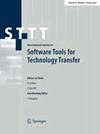从下往上模拟鸟群和蚁群
IF 1.4
3区 计算机科学
Q4 COMPUTER SCIENCE, SOFTWARE ENGINEERING
International Journal on Software Tools for Technology Transfer
Pub Date : 2023-11-02
DOI:10.1007/s10009-023-00731-0
引用次数: 1
摘要
摘要本文提倡使用基于形式语言的组合规范作为建模和分析自然系统中复杂集体行为的手段。通过使用适当的语言结构,可以开发既紧凑又直观的模型,并且可以很容易地细化和扩展小步骤。自动化工作流可以在此方法之上实现,以提供快速反馈,从而实现快速的设计迭代。为了支持我们的观点,我们举了三个自然世界的例子,重点是鸟群和蚁群,它们都是集体适应系统中涌现行为的著名例子。我们使用基于代理的语言来开发简单的模型,旨在捕获这些集体现象,并讨论我们在此过程中使用的特定语言结构。然后,我们采用现有的语言验证工具来模拟我们的模型,并表明我们的模拟确实显示了紧急行为。本文章由计算机程序翻译,如有差异,请以英文原文为准。
Modelling flocks of birds and colonies of ants from the bottom up
Abstract This paper advocates the use of compositional specifications based on formal languages as a means of modelling and analysing sophisticated collective behaviour in natural systems. With the use of appropriate linguistic constructs, models can be developed that are both compact and intuitive, and can be easily refined and extended in small steps. Automated workflows can be implemented on top of this methodology to provide quick feedback, enabling rapid design iterations. To support our argument, we present three examples from the natural world, focusing on flocks of birds and colonies of ants, which feature well-known examples of emergent behaviour in collective adaptive systems. We use an agent-based language to develop simple models that aim at capturing these collective phenomena, and discuss the specific language constructs that we use in the process. Then, we adapt an existing verification tool for the language to simulate our models, and show that our simulations do display emergent behaviour.
求助全文
通过发布文献求助,成功后即可免费获取论文全文。
去求助
来源期刊

International Journal on Software Tools for Technology Transfer
Computer Science-Information Systems
CiteScore
4.50
自引率
6.70%
发文量
39
期刊介绍:
The International Journal on Software Tools for Technology Transfer (STTT) provides a forum for the discussion of all aspects of tools supporting the development of computer systems. It offers, above all, a tool-oriented link between academic research and industrial practice.
Tool support for the development of reliable and correct computer-based systems is of growing importance, and a wealth of design methodologies, algorithms, and associated tools have been developed in different areas of computer science. However, each area has its own culture and terminology, preventing researchers from taking advantage of the results obtained by colleagues in other fields. Tool builders are often unaware of the work done by others, and thus unable to apply it. The situation is even more critical when considering the transfer of new technology into industrial practice.
 求助内容:
求助内容: 应助结果提醒方式:
应助结果提醒方式:


